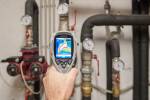Infrared Thermography: What is it and why is it necessary?

Some modifications have been made in the original AI-written article including the addition of images, grammar correction and more to make it align with real-world use cases.
Have you ever heard of infrared thermography? It’s an imaging technique used to detect and measure surface temperatures from a distance. This technology has been around for decades, but only recently has it become a vital tool in the field of industrial diagnostics. In this blog, we’ll explore infrared thermography, showing you why it’s necessary and how it works.
I. Introduction to Infrared Thermography

A. Definition of Infrared Thermography
Infrared thermography is an imaging technique that uses infrared radiation to detect and measure surface temperatures from a distance. It works by absorbing infrared energy emitted by an object, which is then converted into a visible image. By capturing the image, it is possible to measure the temperature of an object without actually touching it. This technology has been used in a variety of settings, including the medical field and industrial settings, to quickly diagnose and identify problems. It is a non-invasive and cost-effective way to detect temperatures and can be used in a wide range of applications.
B. History of Infrared Thermography
Infrared thermography has been around for decades, but it wasn’t until recently that its potential as a tool for industrial diagnostics was realized. The technology was first developed in the 1940s by the US military to detect aircraft. In the 1960s, it was further developed for medical applications, and since then, its use has been expanded to include industrial and commercial settings. Today, infrared thermography is used to detect and measure surface temperatures from a distance and is often used to detect problems quickly and effectively. It is a cost-effective and non-invasive way to detect temperatures, making it an invaluable tool in the industrial and commercial fields.
II. Necessity of Infrared Thermography

A. Uses of Infrared Thermography
Infrared thermography is a technology that uses infrared radiation to create images of objects. It is used to measure and detect the thermal properties of objects and surfaces, detect anomalies, and monitor components and processes. It is used in a variety of applications, such as medical imaging, building thermal insulation, electrical equipment inspection, and automotive diagnostics. Infrared thermography is also used in fields such as industrial maintenance, security, and fire prevention. By detecting anomalies and changes in thermal patterns, it can help detect problems before they become serious issues.
B. Benefits of Infrared Thermography
Infrared thermography has many benefits. It is a non-destructive and non-intrusive form of testing that can be used to quickly identify and diagnose potential problems in a variety of applications. It can also be used to identify areas of excessive energy loss, structural defects, and electrical issues, among other things. Additionally, because it can be used remotely, it is a safe and efficient way to survey large areas or confined spaces. With infrared thermography, technicians can detect potential problems before they escalate, and can take corrective action quickly. This makes it an invaluable tool for preventive maintenance, which can reduce the cost of repairs and increase the lifespan of the equipment.
III. How Infrared Thermography Works

Infrared thermography is a type of imaging that uses infrared radiation to create a picture of a surface. The heat created by the radiation sets off chemical reactions in the target material, which creates an image that can be seen through a camera.
Unlike traditional photography, which uses light that travels through a medium such as air and hits a photographic plate, infrared radiation passes right through people and objects without being absorbed. This allows infrared thermographers to see deep into the tissues of the body, revealing hidden heat sources and abnormalities.
IV. Conclusion
In conclusion, infrared thermography is a valuable tool for detecting potential problems in a variety of environments. It uses thermal radiation to detect differences in temperatures, which can indicate underlying issues that may not be easily visible. Its non-contact, non-destructive nature makes it a safe, cost-effective way to perform inspections and maintenance without needing to take a system offline.
The importance of infrared thermography lies in its ability to detect potential problems before they become bigger and more expensive to fix. With this in mind, it is important that people understand the importance of infrared thermography and take the necessary steps to ensure the safety and functionality of their systems.
While it cannot replace traditional inspection methods, it can be a valuable complement to existing processes.



